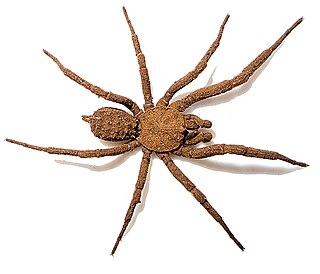
The recluse spiders, also known as brown spiders, fiddle-backs, violin spiders, and reapers, is a genus of spiders that was first described by R. T. Lowe in 1832. They are venomous spiders known for their bite, which sometimes produces a characteristic set of symptoms known as loxoscelism.

Physocyclus is a genus of cellar spiders that was first described by Eugène Louis Simon in 1893.

Psilochorus is a genus of spiders in the family Pholcidae.

Paratropis is a genus of spiders in the family Paratropididae.

Eucteniza is a genus of trapdoor spiders in the family Euctenizidae containing at least 14 species occurring in Mexico and the southern United States. Species are distinguished by a softened rear portion of the carapace, and males possess large spines on the first two pairs of walking legs that are used to hold females during mating. Like other trapdoor spiders they create burrows with a hinged lid, from which they await passing insects and other arthropods to prey upon. Many species are known from only one or two localities, or from only male specimens. More species are expected to be discovered. Eucteniza is closely related to spiders of the genera Entychides and Neoapachella.

Pseudocellus is an arachnid genus in the order Ricinulei, first described by Norman Platnick in 1980. It is native to the Neotropics.
Tengella is a genus of false wolf spiders that was first described by Friedrich Dahl in 1901. It is a senior synonym of Metafecenia.

Ochyrocera is a genus of midget ground weavers that was first described by Eugène Louis Simon in 1892.
Anopsicus is a genus of cellar spiders that was first described by Ralph Vary Chamberlin & Vaine Wilton Ivie in 1938.
Aymaria is a genus of South American cellar spiders that was first described by B. A. Huber in 2000.
Metagonia is a genus of cellar spiders that was first described by Eugène Louis Simon in 1893.
Modisimus is a genus of cellar spiders that was first described by Eugène Louis Simon in 1893.
Pomboa is a genus of Colombian cellar spiders that was first described by B. A. Huber in 2000, and named in honour of Colombian poet Rafael Pombo.
Tolteca is a genus of Mexican cellar spiders that was first described by B. A. Huber in 2000.
Tissahamia is a genus of southeast Asian cellar spiders named after Wanniyalaeto chief Uru Warige Tissahami. It was erected in 20180 for several species transferred from Pholcus after a molecular phylogenetic study of the Calapnita-Panjange clade of Pholcidae. They have long, thin abdomens that bend upward near the end. They also have six eyes, three on each of two eye stalks.
Meraha is a genus of southeast Asian cellar spiders. The genus was erected in 2018 for two species transferred from Pholcus after a molecular phylogenetic study of Pholcidae. The name is derived from the Malay "merah", meaning "red", referring to the reddish-orange hue of pedipalps. They are average sized cellar spiders with a cylindrical abdomen, and they build domed webs .5 to 2 metres above the ground.
Nipisa is a genus of southeast Asian cellar spiders erected in 2018 after a molecular phylogenetic study of Pholcidae. It consists of ten Calapnita species, previously the phyllicola group of Pholcidae, now elevated to genus rank. They are pale whitish in color, with a cylindrical abdomen and relatively long legs. The name is derived from the Malay "nipis", meaning "thin", in reference to the long, thin abdomen.
Loxosceles palma is a species of venomous recluse spider in the family Sicariidae. It is native to Baja California, Mexico. The species name palma comes from the Latin word for palm, and was named as such after the palm canyons in both California, and Baja California.






